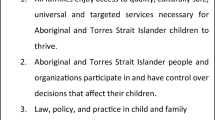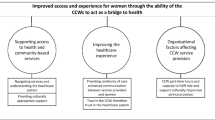Abstract
Objective This descriptive study was intended to identify actual actions, steps and processes of Children with Special Health Care Needs (CSHCN) programs to develop, implement, sustain and assess culturally and linguistically competent policies, structures and practices. Methods An online 52-item mixed format survey of Maternal and Child Health (MCH) CSHCN directors was conducted. In April 2003 and May 2004, 59 directors were solicited to participate in the survey and 42 (86%) responded. Standard quantitative and qualitative analyses of the data were conducted to address key questions linked to the study’s overall objective. Results Findings indicated that almost all respondents are implementing some actions to provide culturally and linguistically competent services including adapting service practices, addressing workforce diversity, providing language access, engaging communities and including requirements in contracts. These individual actions were less often supported by processes such as self-assessment and creating an ongoing structure to systematically address cultural and linguistic competence. Programs are challenged to implement cultural and linguistic competence by state agency organization and budget restrictions. Conclusions The results of the study indicate a continued need for support within state MCH CSHCN programs in order to maintain or enhance the systematic incorporation of culturally and linguistically competent efforts.
Similar content being viewed by others

References
Sullivan, L. W. (2004). Missing persons: Minorities in the health professions. Sullivan Commission.
Institute of Medicine. (2004). In the Nation’s compelling interest: Ensuring diversity in the healthcare workforce. Washington: National Academies Press.
National Healthcare Disparities Report. (2003). Full Report. Rockville, MD: Agency for Healthcare Research and Quality. http://www.ahrq.gov/qual/nhdr03/fullreport/.
Several Authors. (2003). Cultural competence: Special theme articles. Academic Medicine, 78(6), 547–653.
President’s New Freedom Commission on Mental Health. (2003). President’s New Freedom Initiative Final Report. Rockville, MD: U.S. Department of Health Resources and Services Administration, DHHS.
Association of University Centers on Disabilities Network Diversity Survey. (2004). AUCD Network Diversity Survey.
U.S. Census Bureau. American Community Survey. Accessed December 18, 2007 from http://factfinder.census.gov/servlet/DatasetMainPageServlet?_program=ACS&_submenuId=datasets_2&_lang=en.
U.S.Census Bureau. Language Spoken at Home. Accessed December 19, 2007 from http://factfinder.census.gov/servlet/STTable?_bm=y&-geo_id=01000US&-qr_name=ACS_2006_EST_G00_S1601&-ds_name=ACS_2006_EST_G00_.
US Census Bureau. American Fact Finder. Accessed December 18, 2007 from http://factfinder.census.gov/home/saff/main.html?_lang=en.
Day, J. C. (1996). Population projections of the United States by age, sex, race, and Hispanic origin: 1995 to 2050 (Vol. P25). Washington: U.S. Census Bureau, United States Government Printing Office.
Cohen, E., & Goode, T. D. (2003, revised). Policy brief 1: Rationale for cultural competence in primary care. Washington, DC: National Center for Cultural Competence, Georgetown University Center for Child and Human Development.
Institute of Medicine Board on Health Sciences Policy. (2003). Unequal treatment: Confronting racial and ethnic disparities in health care. Institute of Medicine.
van Ryn, M., & Fu, S. S. (2003). Paved with good intentions: Do public health and human service providers contribute to racial/ethnic disparities in health? American Journal of Public Health, 93(2), 248–255.
Kaiser Family Foundation. Racial and ethnic disparities in women’s health coverage and access to care. http://www.kff.org/womenshealth/7018.cfm. Accessed November 3, 2004.
Bach, P. B., Pham, H. H., Schrag, D., Tate, R. C., & Hargraves, J. L. (2004). Primary care physicians who treat blacks and whites. The New England Journal of Medicine, 351(6), 575–584. doi:10.1056/NEJMsa040609.
Wolff, M., Bates, T., Beck, B., Young, S., Ahmed, S. M., & Maurana, C. (2003). Cancer prevention in underserved African American communities: Barriers and effective strategies—a review of the literature. Wisconsin Medical Journal, 102(5), 36–40.
Saha, S., Komaromy, M., Koepsell, T. D., & Bindman, A. B. (1999). Patient-physician racial concordance and the perceived quality and use of health care. Archives of Internal Medicine, 159(9), 997–1004. doi:10.1001/archinte.159.9.997.
Lieu, T. A., et al. (2004). Cultural competence policies and other predictors of asthma care quality for Medicaid-insured children. Pediatrics, 114(1), e102–e110. doi:10.1542/peds.114.1.e102.
Lee, L. J., Batal, H. A., Maselli, J. H., & Kutner, J. S. (2002). Effect of Spanish interpretation method on patient satisfaction in an urban walk-in clinic. Journal of General Internal Medicine, 17(8), 641–645. doi:10.1046/j.1525-1497.2002.10742.x.
Lasater, L. M., Davidson, A. J., Steiner, J. F., & Mehler, P. S. (2001). Glycemic control in English- vs. Spanish-speaking Hispanic patients with type 2 diabetes mellitus. Archives of Internal Medicine, 161(1), 77–82. doi:10.1001/archinte.161.1.77.
Siegel, C., Haugland, G., & Chambers, E. D. (2003). Performance measures and their benchmarks for assessing organizational cultural competency in behavioral health care service delivery. Administration and Policy in Mental Health, 31(2), 141–170. doi:10.1023/B:APIH.0000003019.97009.15.
Kehoe, K. A., Melkus, G. D., & Newlin, K. (2003). Culture within the context of care: An integrative review. Ethnicity and Disease, 13(3), 344–353.
Holland, L., & Courtney, R. (1998). Increasing cultural competence with the Latino community. Journal of Community Health Nursing, 15(1), 45–53. doi:10.1207/s15327655jchn1501_5.
Underwood, S. M., Powe, B., Canales, M., Meade, C. D., & Im, E. O. (2004). Cancer in U.S. ethnic and racial minority populations. Annual Review of Nursing Research, 22, 217–263.
Simpson, L. (2004). Lost in translation? Reflections on the role of research in improving health care for children. Health Affairs (Project Hope), 23(5), 125–130. doi:10.1377/hlthaff.23.5.125.
Brach, C., & Fraser, I. (2002). Reducing disparities through culturally competent health care: An analysis of the business case. Quality Management in Health Care, 10(4), 15–28.
Betancourt, J. R., Green, A. R., Carrillo, J. E., & Ananeh-Firempong, O., I. I. (2003). Defining cultural competence: A practical framework for addressing racial/ethnic disparities in health and health care. Public Health Report, 118(4), 293–302.
Bero, L. A., Grilli, R., Grimshaw, J. M., Harvey, E., Oxman, A. D., & Thomson, M. A. (1998). Closing the gap between research and practice: An overview of systematic reviews of interventions to promote the implementation of research findings. The Cochrane Effective Practice and Organization of Care Review Group. British Medical Journal, 317(7156), 465–468.
Child and Adolescent Health Measurement Initiative. National Survey of Children with Special Health Care Needs. http://cahmi.org/pages/Home.aspx. Accessed November 4, 2007.
Maternal and Child Health Bureau. Maternal and Child Health Bureau Strategic Plan: FY 2003–2007. ftp://ftp.hrsa.gov//mchb/stratplan03-07.pdf. Accessed November 4, 2004.
Cohen, E., & Goode, T. D. (1999). Policy brief 1: Rationale for cultural competence in primary care. Washington, DC: National Center for Cultural Competence, Georgetown University Center for Child and Human Development.
Dunne, C., Goode, T., & Sockalingham, S. (2003). Planning for cultural and linguistic competence in state Title V programs serving children and youth with special health care needs and their families. Washington, DC: National Center for Cultural Competence, Georgetown University Center for Child and Human Development.
Version, S.P.S.S. (2002). 11.0 [computer program]. Version. Chicago.
Strauss, A. L. (1987). Qualitative analysis for social scientists. Cambridge: Cambridge University Press.
Miles, M., & Huberman, M. (1994). Qualitative analysis: An expanded sourcebook (2nd ed.). Thousand Oaks: Sage Publications.
Kirk, J., & Miller, M. L. (1985). Reliability and validity in qualitative research. Newbury Park: Sage Publications.
Acknowledgments
Eileen Miller, BS, the staff of the National Center for Cultural Competence and the State CSHCN Directors, without all of whom this study would have not been possible. This study was funded through Cooperative Agreement #U93-MC-00145 from the Maternal and Child Health program (Title V, Social Security Act), HRSA, DHHS.
Author information
Authors and Affiliations
Corresponding author
Rights and permissions
About this article
Cite this article
Telfair, J., Bronheim, S.M. & Harrison, S. Implementation of Culturally and Linguistically Competent Policies by State Title V Children with Special Health Care Needs (CSHCN) Programs. Matern Child Health J 13, 677–686 (2009). https://doi.org/10.1007/s10995-008-0407-4
Received:
Accepted:
Published:
Issue Date:
DOI: https://doi.org/10.1007/s10995-008-0407-4



